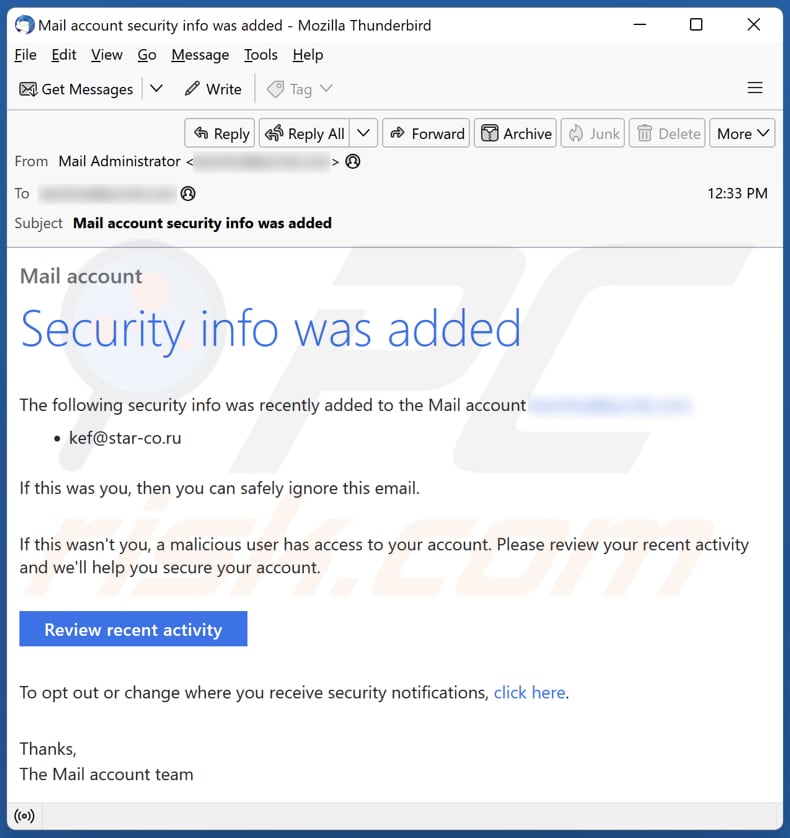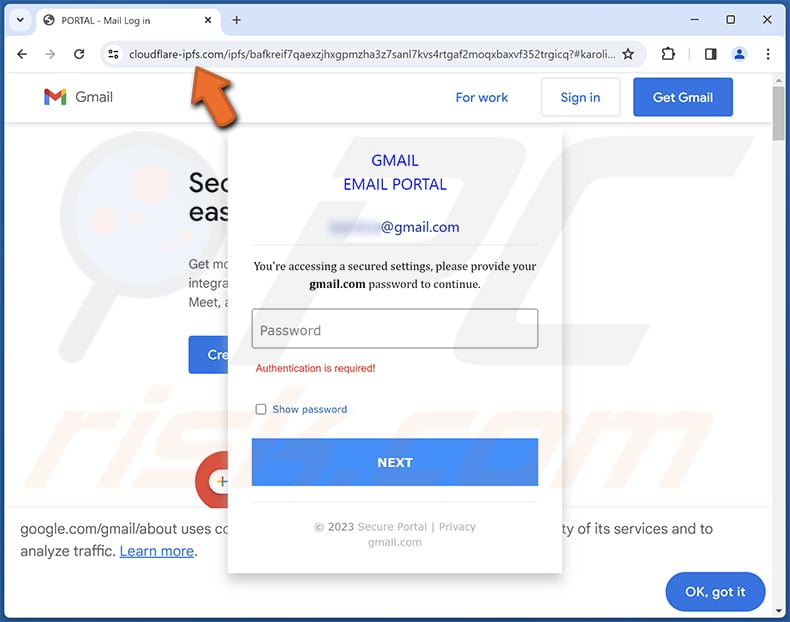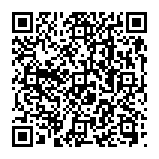How to identify fake emails like "Security Info Was Added"
![]() Written by Tomas Meskauskas on (updated)
Written by Tomas Meskauskas on (updated)
What kind of scam is "Security Info Was Added"?
During our examination, we have determined that the intent of this email is to deceive recipients into revealing personal information on a fraudulent website. The message is disguised as a notification from an email service provider and includes a deceptive link leading to a phishing page.

More about the "Security Info Was Added" scam email
This email claims that security information has been added to a Mail account. It includes a message suggesting that if the recipient recognizes this action, they can safely ignore the email. However, if the recipient did not authorize the addition of security information, it warns that a malicious user may have gained access to their account.
The email encourages the recipient to review their recent account activity and offers assistance in securing their account. Additionally, a link is provided to "Review recent activity" and an option to opt out or change preferences for receiving security notifications.
The hyperlinks within this email lead to a deceptive webpage designed to replicate the login interface of the recipient's email service provider. For instance, if the recipient utilizes Gmail, the phishing page mirrors the appearance of the Gmail sign-in portal. In either case, the primary objective of this fraudulent page is to obtain the login credentials for the email account.
Once scammers obtain email account login credentials, they can hijack an email account to launch phishing attacks on the victim's contacts. Additionally, scammers may use the stolen email credentials for identity theft or unauthorized access to other online accounts associated with the victim.
Moreover, stolen email accounts can also be sold on the dark web, contributing to a broader black market for compromised credentials. In this illicit trade, cybercriminals buy and sell access to hacked accounts, exacerbating the potential harm to individuals and organizations.
| Name | Security Info Was Added Email Scam |
| Threat Type | Phishing, Scam, Social Engineering, Fraud |
| Fake Claim | Security measures have been implemented to secure email account |
| Disguise | Notification from an email service provider |
| Symptoms | Unauthorized online purchases, changed online account passwords, identity theft, illegal access of the computer. |
| Distribution methods | Deceptive emails, rogue online pop-up ads, search engine poisoning techniques, misspelled domains. |
| Damage | Loss of sensitive private information, monetary loss, identity theft. |
| Malware Removal (Windows) | To eliminate possible malware infections, scan your computer with legitimate antivirus software. Our security researchers recommend using Combo Cleaner. |
Similar scam emails in general
Typically, these emails employ urgent or alarming language to create a sense of urgency, urging recipients to act quickly without thorough consideration. They often mimic the appearance of legitimate communication, imitating trusted entities such as banks, email providers, or government agencies.
Phishing emails commonly contain links or attachments that, when clicked, lead to fraudulent websites or malware downloads. Examples of similar emails are "DHL - Outstanding Payment", "AliExpress Package", and "Temu - Pending Package Delivery".
How do spam campaigns infect computers?
Computers can become infected through malicious attachments. Threat actors often send emails containing seemingly innocent attachments, such as documents or executables, which, when opened, can deploy malware onto the recipient's computer.
Another prevalent technique involves links embedded in emails. These deceptive messages appear legitimate, often impersonating trusted entities like banks or government agencies. If recipients click the provided links, they may be directed to fraudulent websites hosting malware or triggering malicious drive-by downloads.
How to avoid installation of malware?
Install trustworthy antivirus and anti-malware programs on your computer, and keep them updated to identify and eliminate the newest threats. Keep your operating system and installed software up to date. Refrain from clicking on links or downloading attachments from emails from untrusted sources.
Additionally, avoid downloading pirated software and cracking tools. Steer clear of engaging with advertisements and pop-ups on questionable websites. Obtain applications and files exclusively from official websites and authorized app stores.
If you have already opened malicious attachments, we recommend running a scan with Combo Cleaner Antivirus for Windows to automatically eliminate infiltrated malware.
Text presented in the "Security Info Was Added" email letter:
Subject: Mail account security info was added
Mail account
Security info was added
The following security info was recently added to the Mail account ********:kef@star-co.ru
If this was you, then you can safely ignore this email.
If this wasn't you, a malicious user has access to your account. Please review your recent activity and we'll help you secure your account.
Review recent activity
To opt out or change where you receive security notifications, click here.
Thanks,
The Mail account team
Phishing website presented in this email:

Instant automatic malware removal:
Manual threat removal might be a lengthy and complicated process that requires advanced IT skills. Combo Cleaner is a professional automatic malware removal tool that is recommended to get rid of malware. Download it by clicking the button below:
▼ DOWNLOAD Combo Cleaner
By downloading any software listed on this website you agree to our Privacy Policy and Terms of Use. To use full-featured product, you have to purchase a license for Combo Cleaner. 7 days free trial available. Combo Cleaner is owned and operated by Rcs Lt, the parent company of PCRisk.com read more.
Quick menu:
- What is Security Info Was Added phishing campaign?
- Types of malicious emails.
- How to spot a malicious email?
- What to do if you fell for an email scam?
Types of malicious emails:
![]() Phishing Emails
Phishing Emails
Most commonly, cybercriminals use deceptive emails to trick Internet users into giving away their sensitive private information, for example, login information for various online services, email accounts, or online banking information.
Such attacks are called phishing. In a phishing attack, cybercriminals usually send an email message with some popular service logo (for example, Microsoft, DHL, Amazon, Netflix), create urgency (wrong shipping address, expired password, etc.), and place a link which they hope their potential victims will click on.
After clicking the link presented in such email message, victims are redirected to a fake website that looks identical or extremely similar to the original one. Victims are then asked to enter their password, credit card details, or some other information that gets stolen by cybercriminals.
![]() Emails with Malicious Attachments
Emails with Malicious Attachments
Another popular attack vector is email spam with malicious attachments that infect users' computers with malware. Malicious attachments usually carry trojans that are capable of stealing passwords, banking information, and other sensitive information.
In such attacks, cybercriminals' main goal is to trick their potential victims into opening an infected email attachment. To achieve this goal, email messages usually talk about recently received invoices, faxes, or voice messages.
If a potential victim falls for the lure and opens the attachment, their computers get infected, and cybercriminals can collect a lot of sensitive information.
While it's a more complicated method to steal personal information (spam filters and antivirus programs usually detect such attempts), if successful, cybercriminals can get a much wider array of data and can collect information for a long period of time.
![]() Sextortion Emails
Sextortion Emails
This is a type of phishing. In this case, users receive an email claiming that a cybercriminal could access the webcam of the potential victim and has a video recording of one's masturbation.
To get rid of the video, victims are asked to pay a ransom (usually using Bitcoin or another cryptocurrency). Nevertheless, all of these claims are false - users who receive such emails should ignore and delete them.
How to spot a malicious email?
While cyber criminals try to make their lure emails look trustworthy, here are some things that you should look for when trying to spot a phishing email:
- Check the sender's ("from") email address: Hover your mouse over the "from" address and check if it's legitimate. For example, if you received an email from Microsoft, be sure to check if the email address is @microsoft.com and not something suspicious like @m1crosoft.com, @microsfot.com, @account-security-noreply.com, etc.
- Check for generic greetings: If the greeting in the email is "Dear user", "Dear @youremail.com", "Dear valued customer", this should raise suspiciousness. Most commonly, companies call you by your name. Lack of this information could signal a phishing attempt.
- Check the links in the email: Hover your mouse over the link presented in the email, if the link that appears seems suspicious, don't click it. For example, if you received an email from Microsoft and the link in the email shows that it will go to firebasestorage.googleapis.com/v0... you shouldn't trust it. It's best not to click any links in the emails but to visit the company website that sent you the email in the first place.
- Don't blindly trust email attachments: Most commonly, legitimate companies will ask you to log in to their website and to view any documents there; if you received an email with an attachment, it's a good idea to scan it with an antivirus application. Infected email attachments are a common attack vector used by cybercriminals.
To minimise the risk of opening phishing and malicious emails we recommend using Combo Cleaner Antivirus for Windows.
Example of a spam email:

What to do if you fell for an email scam?
- If you clicked on a link in a phishing email and entered your password - be sure to change your password as soon as possible. Usually, cybercriminals collect stolen credentials and then sell them to other groups that use them for malicious purposes. If you change your password in a timely manner, there's a chance that criminals won't have enough time to do any damage.
- If you entered your credit card information - contact your bank as soon as possible and explain the situation. There's a good chance that you will need to cancel your compromised credit card and get a new one.
- If you see any signs of identity theft - you should immediately contact the Federal Trade Commission. This institution will collect information about your situation and create a personal recovery plan.
- If you opened a malicious attachment - your computer is probably infected, you should scan it with a reputable antivirus application. For this purpose, we recommend using Combo Cleaner Antivirus for Windows.
- Help other Internet users - report phishing emails to Anti-Phishing Working Group, FBI’s Internet Crime Complaint Center, National Fraud Information Center and U.S. Department of Justice.
Frequently Asked Questions (FAQ)
Why did I receive this email?
Criminals dispatch identical letters to thousands of recipients, banking on the hope that someone among the recipients will be deceived. These phishing emails lack any personalization.
I have provided my email account login credentials when tricked by this email, what should I do?
Access your email account settings and change your password immediately. Also, report the phishing incident to your email service provider.
I have downloaded and opened a malicious file attached to an email, is my computer infected?
Opening a malicious file downloaded from an email poses a substantial risk of malware infection for your computer, particularly if the file is executable. However, other files (e.g., PDF or MS Office documents) cannot infect computers unless additional steps are taken.
I have read the email but did not open the attachment, is my computer infected?
Merely opening an email poses no threat. System infections can occur when clicking links within the email or opening attached files.
Will Combo Cleaner remove malware infections that were present in email attachment?
Combo Cleaner has the capability to detect and eliminate nearly all known malware infections. Since sophisticated malware often conceals itself deep within the system, running a full system scan is imperative for effective detection and removal.


▼ Show Discussion